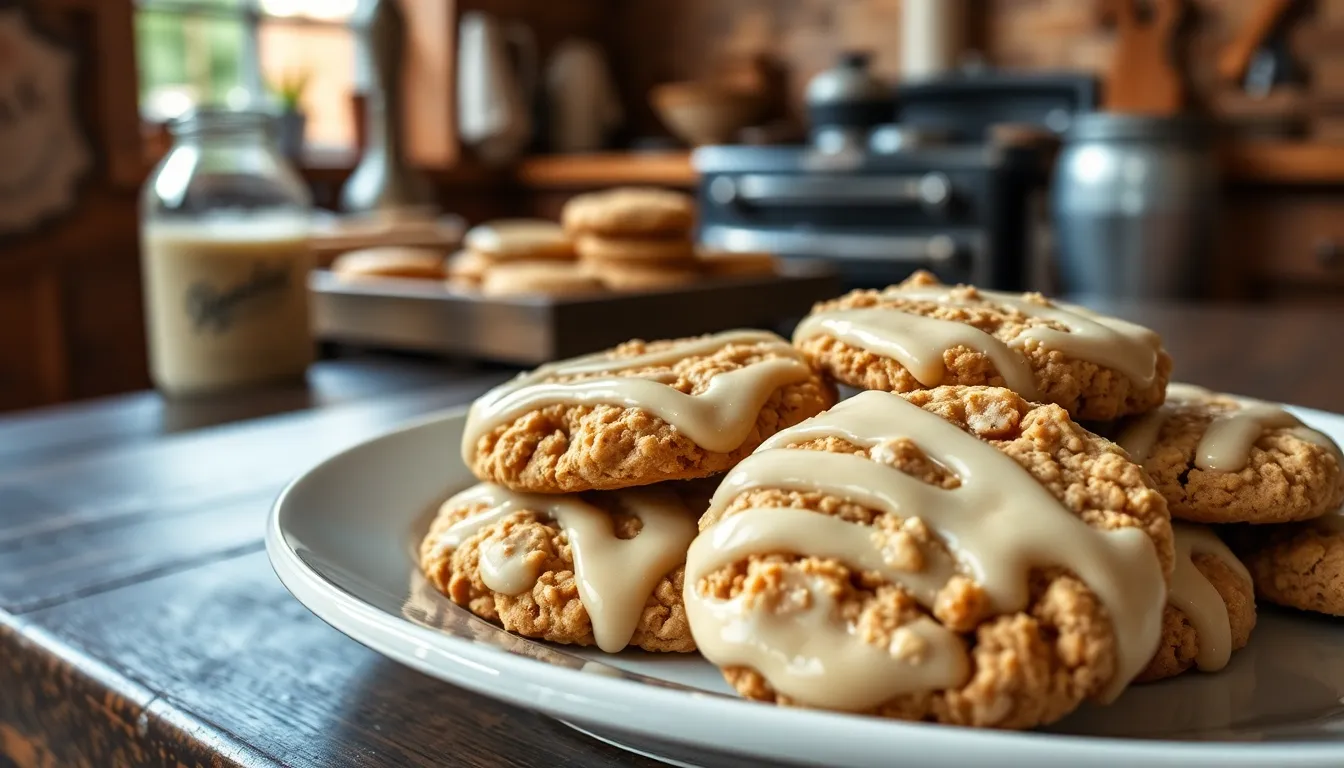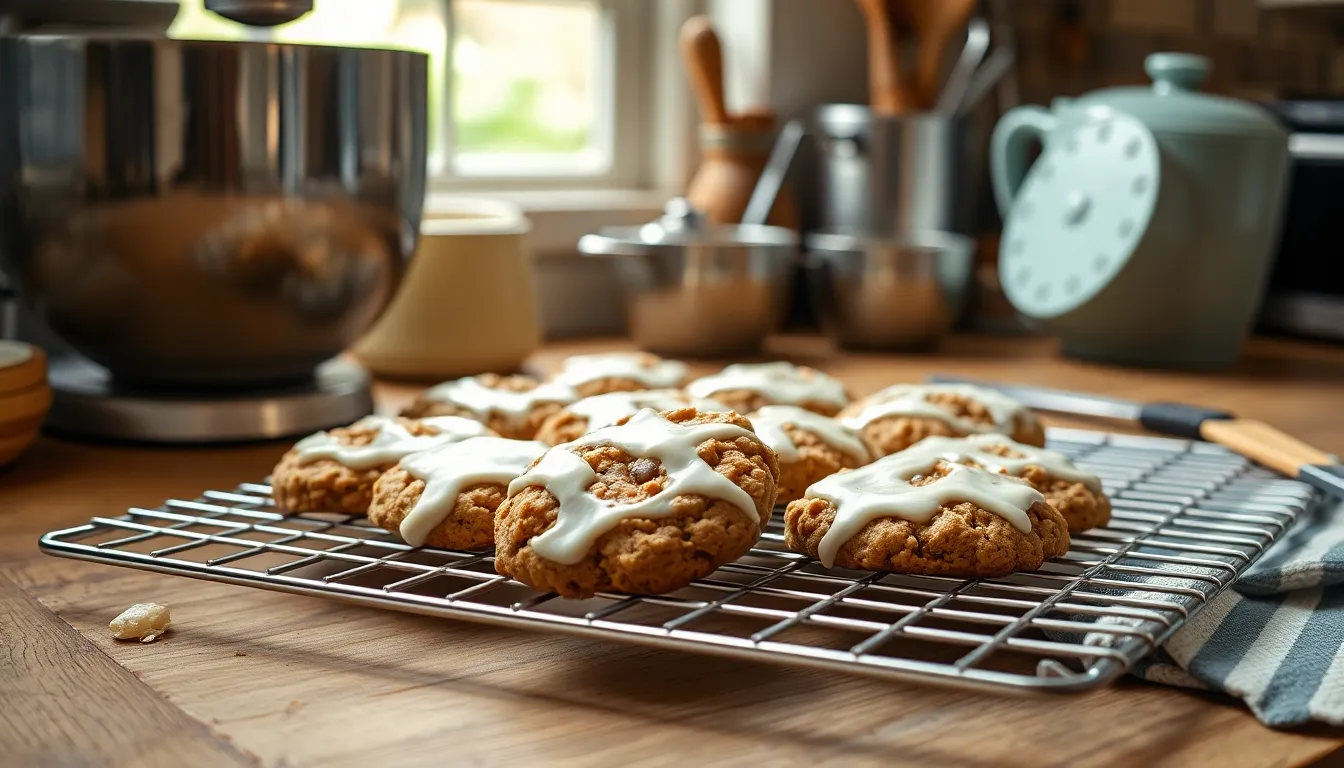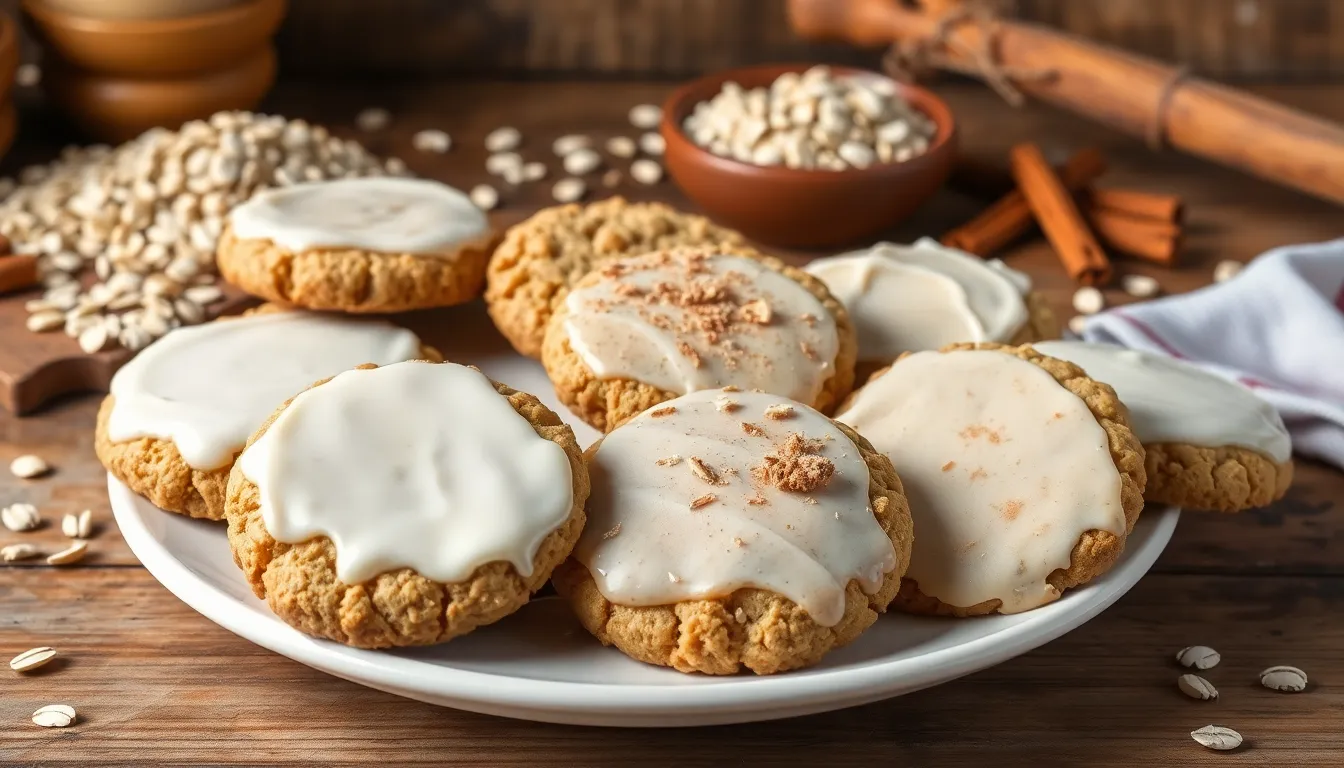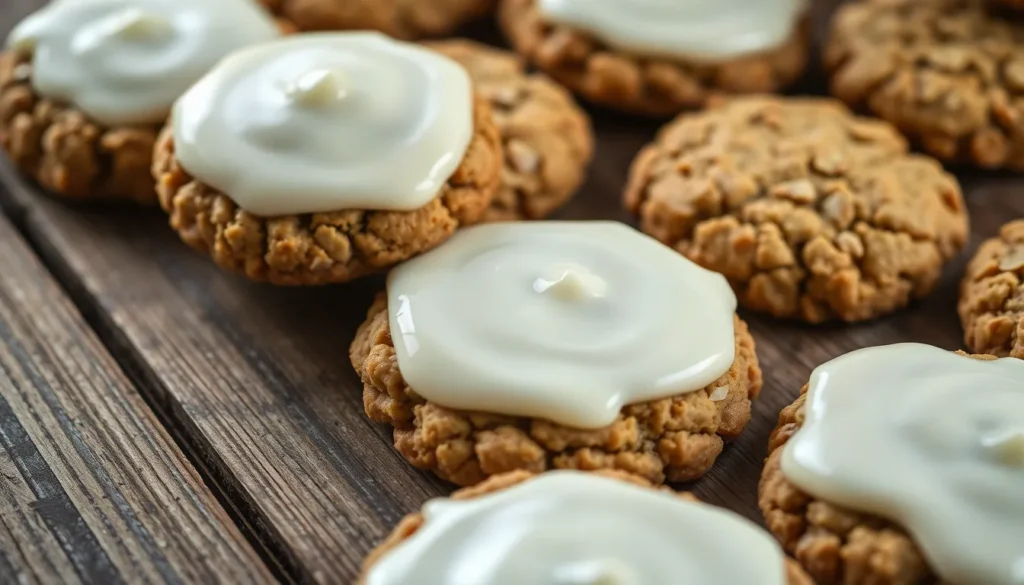We’ve discovered the perfect balance between chewy oatmeal goodness and sweet vanilla glaze in these irresistible iced oatmeal cookies. These aren’t your grandmother’s plain oatmeal cookies – they’re elevated with a smooth cream cheese frosting that transforms an everyday treat into something truly special.
What makes these cookies stand out is their incredible texture. We use old-fashioned oats for that hearty chew while keeping the cookies tender and soft. The secret lies in our technique of slightly underbaking them so they stay perfectly chewy even after cooling.
The crowning glory is the simple yet decadent icing that hardens just enough to create a delightful contrast with the soft cookie underneath. Whether you’re packing lunch boxes or hosting a gathering these iced oatmeal cookies deliver comfort food satisfaction with an elegant twist that’ll have everyone asking for the recipe.
Equipment Needed
We need exact tools to create these perfectly textured iced oatmeal cookies with their signature chewy center and smooth frosting. Our equipment list focuses on achieving the ideal cookie consistency and professional-looking glaze application.
Essential Baking Equipment:
- Large mixing bowl for combining dry ingredients
- Medium mixing bowl for wet ingredients
- Electric mixer (stand mixer or hand mixer) for creaming butter and sugar
- Measuring cups and spoons for accurate ingredient portions
- Cookie scoop or tablespoon for uniform cookie sizes
- Baking sheets (2-3 sheets recommended for efficient batching)
- Parchment paper or silicone baking mats to prevent sticking
- Wire cooling racks for proper cookie cooling
Frosting and Icing Tools:
- Small saucepan for warming cream cheese frosting ingredients
- Whisk for smooth frosting consistency
- Offset spatula or butter knife for spreading icing
- Small bowl for mixing vanilla glaze
- Rubber spatula for scraping bowls clean
Optional but Helpful Equipment:
- Kitchen scale for precise measurements
- Timer to prevent overbaking
- Cooling rack with raised edges to catch dripping icing
Our equipment selection ensures we achieve the slightly underbaked texture that makes these cookies exceptionally chewy. The electric mixer creates the proper butter and sugar consistency while the wire cooling racks allow proper air circulation during the cooling process before we apply our cream cheese frosting.
Ingredients

Creating these irresistible iced oatmeal cookies requires two distinct sets of ingredients for optimal results. We’ll prepare both the cookie base and the smooth vanilla icing to achieve that perfect balance of chewy texture and sweet glaze.
For the Cookies
- 1½ cups old-fashioned rolled oats
- 1 cup all-purpose flour
- 1 teaspoon baking soda
- ½ teaspoon salt
- 1 teaspoon ground cinnamon
- ¼ teaspoon ground nutmeg
- ½ cup unsalted butter, softened
- ¾ cup packed brown sugar
- ¼ cup granulated sugar
- 1 large egg
- 2 tablespoons molasses
- 1 teaspoon vanilla extract
For the Icing
- 1½ cups confectioners’ sugar
- 3-4 tablespoons milk or heavy cream
- 1 teaspoon vanilla extract
- Pinch of salt
| Component | Primary Ingredients |
|---|---|
| Cookie Base | Oats, flour, baking soda, spices, butter, sugars, egg |
| Icing | Confectioners’ sugar, liquid (milk/cream), vanilla extract |
Instructions

Now that we have our ingredients and equipment ready, let’s walk through the process of creating these delicious iced oatmeal cookies. We’ll start by preparing the dough and move through each step to achieve that perfect chewy texture with a sweet vanilla glaze.
Prep the Cookie Dough
We begin by pulsing the rolled oats in a food processor for about 20 seconds until they achieve a coarse texture. This creates the ideal consistency for our cookies without making the oats too fine.
In a medium bowl, we combine the pulsed oats with flour, baking powder, baking soda, cornstarch, salt, cinnamon, and nutmeg. Whisk these dry ingredients together until evenly distributed.
Using our stand mixer, we beat the room temperature butter with both dark brown sugar and granulated sugar until the mixture becomes light and creamy. Add the eggs one at a time, ensuring each is fully incorporated before adding the next. Pour in the vanilla extract and mix until combined.
Gradually add our dry ingredient mixture to the wet ingredients, beating on low speed until just combined. Avoid overmixing to maintain the tender texture we want in our finished cookies.
Bake the Cookies
Preheat the oven to 350°F and line our baking sheets with parchment paper. Using a medium cookie scoop, we form the dough into 1.5-inch balls and place them 2 inches apart on the prepared baking sheets.
Bake the cookies for 12 to 13 minutes, rotating the pans halfway through the baking time for even browning. The cookies should look set around the edges but still appear slightly soft in the center.
Allow the cookies to cool on the baking sheets for 5 minutes before transferring them to wire racks. This cooling time prevents the cookies from breaking while still warm and helps them maintain their chewy texture.
Make the Icing
In a medium bowl, we whisk together powdered sugar, vanilla extract, and heavy cream until smooth. Start with less cream and gradually add more until we reach our desired consistency.
The icing should be thick enough to coat the cookies but thin enough to spread easily. If the mixture becomes too thick, add cream one teaspoon at a time until we achieve the perfect consistency.
Ice the Cookies
Once our cookies have cooled completely, we gently dip the top of each cookie into the prepared icing. Hold each cookie briefly over the bowl to allow excess icing to drip off.
Place the iced cookies on a wire rack with parchment paper underneath to catch any drips. Allow the icing to set for at least 15 minutes before serving or storing the cookies.
Make-Ahead Instructions

Planning ahead makes baking these delicious iced oatmeal cookies even more convenient. We’ve tested several methods to help you prepare these treats in advance without compromising their signature chewy texture or creamy glaze.
Refrigerating the Dough
Cookie dough benefits from proper chilling before baking. We recommend refrigerating the prepared dough for at least 1 hour before shaping and baking. This resting period allows the flour to fully absorb the wet ingredients while improving the overall texture of our finished cookies.
For longer storage, the dough keeps beautifully in the refrigerator for up to 4 days when wrapped tightly in plastic wrap or stored in an airtight container. Before baking, allow the chilled dough to come to room temperature for easier handling and uniform baking results.
Freezing Unbaked Cookies
Freezing shaped cookie dough gives us ultimate flexibility for fresh-baked treats anytime. After scooping the dough into portions, place the unbaked cookies on a baking sheet lined with parchment paper. Freeze them flat for 1 hour until solid.
Transfer the frozen cookie portions to an airtight container or freezer bag where they’ll maintain their quality for up to 2 months. Label the container with the date and baking instructions for easy reference later.
Storage Timeline Reference
| Storage Method | Duration | Temperature | Notes |
|---|---|---|---|
| Refrigerated Dough | Up to 4 days | 35-40°F | Bring to room temperature before baking |
| Frozen Unbaked Cookies | Up to 2 months | 0°F | Bake directly from frozen, add 1-2 minutes |
| Dough Resting Time | At least 1 hour | 35-40°F | Improves texture and flavor |
Baking from Frozen
Frozen cookie portions bake directly from the freezer without thawing. Add 1 to 2 additional minutes to the original baking time and watch for the characteristic lightly golden edges that signal doneness. The centers should still appear slightly underbaked when we remove them from the oven.
These make-ahead techniques ensure we always have fresh iced oatmeal cookies ready for unexpected guests or planned celebrations without the stress of last-minute preparation.
Storage Tips

We recommend several storage methods to keep your iced oatmeal cookies fresh and maintain their perfect chewy texture. Proper storage ensures you can enjoy these delicious treats for days or even months after baking.
Room Temperature Storage works best for short-term enjoyment. Store your cookies in an airtight container at room temperature for up to 3 days. This method preserves the moisture content that makes our iced oatmeal cookies so irresistibly chewy.
Refrigerated Storage extends the lifespan of your cookies when you need more time. Place the cookies in an airtight container and refrigerate for up to 1 week. This approach works perfectly for both soft and crispy cookie varieties while maintaining their quality.
Freezing Baked Cookies provides the longest storage option for our iced oatmeal cookies. First place the cookies on a baking sheet for about one hour until they become firm. Transfer them to a freezer bag or airtight container where they can be stored for up to 2 months without losing their delicious flavor.
Freezing Cookie Dough offers incredible convenience for future baking sessions. Wrap the prepared dough tightly in plastic wrap before storing it in the freezer. When you’re ready to bake thaw the dough overnight in the refrigerator for best results.
Container Selection and Labeling makes a important difference in storage success. Always use airtight containers to prevent moisture and air from compromising your cookies’ texture and taste. Label each container with the date and cookie type to easily track freshness and ensure you enjoy them at their peak quality.
| Storage Method | Duration | Container Type |
|---|---|---|
| Room Temperature | Up to 3 days | Airtight container |
| Refrigerated | Up to 1 week | Airtight container |
| Frozen Cookies | Up to 2 months | Freezer bag or airtight container |
| Frozen Dough | Extended storage | Plastic wrap |
Variations and Substitutions

These iced oatmeal cookies offer endless possibilities for customization to suit different tastes and dietary needs. We can transform the base recipe with creative variations that enhance both flavor and texture.
Cookie Variations
Spiced Oatmeal Cookies elevate the traditional recipe by incorporating additional warming spices. We recommend adding extra cinnamon for depth or experimenting with nutmeg, ginger, or cardamom to create a more complex flavor profile that pairs beautifully with the vanilla icing.
Oatmeal Raisin Cookies bring classic comfort to the table. We substitute a portion of the oats with plump raisins, which add natural sweetness and chewy texture that complements the existing oat base perfectly.
Oatmeal Chocolate Chip Cookies offer an irresistible contrast. We fold in semi-sweet chocolate chips to create pockets of rich flavor that balance the wholesome oat taste with indulgent sweetness.
Oatmeal Scotchies provide a unique twist using butterscotch chips instead of chocolate. These golden morsels deliver a buttery, caramel-like flavor that transforms the cookies into something special.
Texture variations allow us to experiment with different oat types. While we typically use old-fashioned rolled oats for the ideal chewy texture, steel-cut oats or a combination of both creates an interesting variation with more pronounced texture and nuttiness.
Icing Variations
Vanilla Icing remains our classic choice, combining confectioners’ sugar, vanilla extract, and heavy cream for the perfect balance of sweetness and flavor. This traditional glaze complements the oatmeal cookies without overwhelming their natural taste.
Almond Icing offers a sophisticated alternative. We substitute vanilla extract with almond extract to create a nutty, aromatic glaze that adds elegance to these homestyle cookies.
Cinnamon Sugar Glaze brings warmth and spice to the forefront. We mix confectioners’ sugar with ground cinnamon and a splash of milk to create a glaze that echoes the warming spices within the cookies themselves.
Colored Icing transforms these cookies for special occasions. We add food coloring to our basic vanilla icing recipe to match party themes, holidays, or seasonal celebrations while maintaining the same delicious taste.
Substitution options help accommodate different dietary preferences. We can replace brown sugar with honey or maple syrup for natural sweetness, use coconut oil or vegan butter instead of regular butter for dairy-free versions, or swap cinnamon for ginger or nutmeg to create different spice profiles that suit individual tastes.
Troubleshooting Tips

Even experienced bakers encounter challenges when making iced oatmeal cookies. We’ve compiled the most common issues and their answers to help you achieve perfect results every time.
Cookie Shape and Spread Issues
Cookies spread too much during baking: This typically occurs when we don’t have enough oat flour in our mixture. We recommend adjusting the ratio by pulsing more oats into flour for future batches. The oat flour provides structure that prevents excessive spreading.
Achieving perfectly round cookies: We can fix irregularly shaped cookies while they’re still warm from the oven. Use a round cookie cutter or wide mouth glass to gently circle around each cookie. This technique works best when cookies are warm but not hot.
| Issue | Solution | Timing |
|---|---|---|
| Excessive spreading | Increase oat flour ratio | Next batch |
| Irregular shape | Use round cutter while warm | Immediately after baking |
Icing Application Problems
Icing consistency troubles: We need to achieve the right balance for proper application. Icing that’s too thin will run off the cookies completely. Icing that’s too thick won’t stick properly to the surface. Test consistency by lifting the whisk and watching how the icing falls back into the bowl.
Proper dipping technique: We should lightly dip only the tops of our cookies into the icing. Avoid submerging the entire cookie as this creates excessive coating and messy results. A gentle dip allows for even coverage without overwhelming the cookie.
Timing and Temperature Answers
Cooling requirements: We must allow cookies to cool completely on a wire rack before applying icing. Warm cookies will cause the icing to melt or spread unevenly across the surface.
Leftover icing storage: We can store unused icing in an airtight container with plastic wrap pressed directly onto the surface. This prevents a skin from forming and keeps the icing smooth for future projects like drizzling or glazing other baked goods.
Quick Reference Answers
When cookies don’t turn out as expected we can often salvage the batch with these immediate fixes. Warm cookies can be reshaped using kitchen tools. Improperly iced cookies can be gently scraped clean and re-iced once cooled. These troubleshooting techniques ensure our iced oatmeal cookies always meet our standards for both appearance and taste.
Serving Suggestions

These iced oatmeal cookies shine in countless serving scenarios, making them versatile treats for any occasion. We recommend pairing them with a tall glass of cold milk, which perfectly complements the sweet vanilla icing and creates a nostalgic combination that both children and adults adore.
For cozy winter evenings, we love serving these cookies alongside a steaming cup of hot chocolate. The warm spices of cinnamon and nutmeg in the cookies harmonize beautifully with rich cocoa, creating a comforting treat that warms the soul.
Coffee enthusiasts will find these cookies make excellent companions to their morning brew or afternoon espresso. The sweet icing balances the bitter notes in coffee, while the chewy oat texture provides a satisfying contrast to smooth beverages.
We often arrange these decorated cookies on dessert platters for special gatherings and celebrations. Their attractive vanilla glaze makes them presentation-ready without additional garnishing, and the individual portions eliminate the need for serving utensils.
Pack them in lunch boxes for school or work, where they travel well and maintain their chewy texture throughout the day. The icing sets firmly enough to prevent messy transfers while keeping the cookies moist and flavorful.
During holiday seasons, we display these cookies on tiered stands alongside other baked goods. Their classic appearance and familiar flavors appeal to guests of all ages, making them reliable crowd-pleasers at parties and family reunions.
For afternoon tea service, we cut these cookies slightly smaller and arrange them on delicate plates. The vanilla icing elevates their elegance, making them suitable for more formal entertaining occasions.
Temperature matters when serving these treats. We find they taste best at room temperature, which allows the full flavor profile to emerge and maintains the ideal chewy texture that makes them so appealing.
Conclusion
These iced oatmeal cookies truly represent the perfect balance of comfort and elegance. We’ve equipped you with everything needed to create bakery-quality treats that’ll become a household favorite.
The beauty of this recipe lies in its flexibility – whether you’re making them for weekday snacks or special celebrations they consistently deliver that coveted chewy texture paired with a luscious vanilla glaze.
With our make-ahead tips storage guidance and troubleshooting advice you’re set up for success every time. Don’t be afraid to experiment with the variations we’ve shared to make these cookies uniquely yours.
Now it’s time to preheat that oven and start creating memories one delicious batch at a time!
Frequently Asked Questions
What makes these iced oatmeal cookies different from regular oatmeal cookies?
These cookies feature a unique chewy texture achieved by pulsing old-fashioned oats and slightly underbaking them. They’re topped with a smooth cream cheese frosting that adds a decadent vanilla glaze, making them more elegant than traditional oatmeal cookies while maintaining that comforting homemade taste.
How long do iced oatmeal cookies stay fresh?
At room temperature in an airtight container, they last up to 3 days. Refrigerated storage extends freshness to 1 week, while frozen baked cookies can be stored for up to 2 months. Always use airtight containers and label them to track freshness for optimal quality.
Can I make the cookie dough ahead of time?
Yes! Refrigerate prepared dough for at least 1 hour before baking to improve texture. The dough keeps in the refrigerator for up to 4 days or can be frozen for up to 2 months. You can also freeze unbaked cookies and bake directly from frozen with slight time adjustments.
What equipment do I need to make these cookies?
Essential tools include mixing bowls, an electric mixer, measuring cups and spoons, baking sheets, and cooling racks. Optional but helpful items are a kitchen scale for precision and a timer to prevent overbaking. These tools ensure proper cookie consistency and professional-looking glaze application.
What are some popular variations of these iced oatmeal cookies?
Popular cookie variations include adding raisins, chocolate chips, or butterscotch chips. You can also make spiced versions with extra cinnamon and nutmeg. For icing variations, try almond extract instead of vanilla, cinnamon sugar glaze, or colored icing for special occasions and holidays.
Why are my cookies spreading too much during baking?
Excessive spreading usually indicates too much butter or insufficient oat flour. Try chilling the dough for at least 1 hour before baking, use the correct oat-to-flour ratio, and ensure your oven is properly preheated to 350°F. Properly measured ingredients are crucial for maintaining cookie shape.
How should I serve these iced oatmeal cookies?
These versatile cookies pair wonderfully with cold milk, hot chocolate, or coffee. They’re perfect for dessert platters, lunch boxes, and holiday displays. For afternoon tea, make smaller versions and serve at room temperature to fully enjoy their chewy texture and flavor.
Can I make dietary substitutions in this recipe?
Yes! For dairy-free versions, substitute coconut oil or vegan butter for regular butter. Replace brown sugar with honey or maple syrup if preferred. You can also use gluten-free flour blends, though texture may vary slightly. These substitutions allow everyone to enjoy these delightful cookies.







